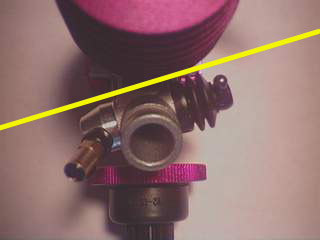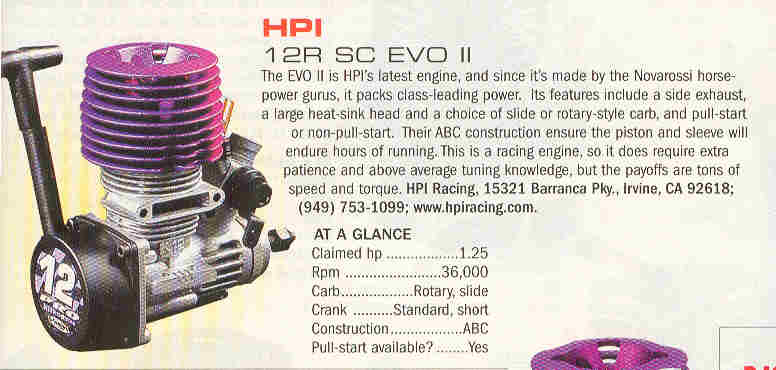|
|
|
![]()

![]()
 |
|
|
OFNA
Hyper 21 PullStart ABC
|
|
| Part # | 51216 |
| Engine | .21 Pullstart |
| Displacement (cu in) | (3.49 cc) |
| Bore (in) | (16.26mm) |
| Stroke (in) | (16.8mm) |
| RPM | 2,500-38,000 |
| Output (BHP@rpm) | 2.1 hp @ 35,000 |
I've recently installed an OFNA .21 hyper into my NMT and I am very happy with it. After finishing break-in I found the engine to have lots of power. I have not leaned it out too much on account of the cold weather, but plan to see how fast my NMT goes sometime soon.
These size comparisons between the .21 OFNA Hyper and the .12 HPI Evo II give you an idea of what we're dealing with in the conversion.
Left and right shots of the Novarossi manufactured HPI Evo II. This .12 powerhouse is manufactured in Italy. The engine rides on Wolfpack Radical heat sink motor mounts and the momentum is maintained by the Wolfpack Radical aluminum vented flywheel. This .12 engine requires a .21 air filter, as you can see the Motorsaver's air filter above is huge. Under the clutch bell I have a performance clutch set to the second hole with the first hole cut off.
You can kind of see the venting holes in the flywheel.

That carb opening is huge! You will also notice that I rotated the slide carb so that the linkage angle matches. The servo will move your throttle linkage on a certain angle. You want the sliding part of your carb to slide at the same angle. Otherwise, you risk binding and the carb will act erratic when it binds.
I use an OFNA slide carb linkage kit, and this comes with everything you need to setup your slide carb. When you go to hook everything up, start with your throttle servo in neutral. I like to put a little tension on the spring, but the spring has to be able compress as much as it needs to when you hit the brake. Adjust your full throttle enpoints by listening to the servo, just keep taking it down until the servo stops growling. For the brake enpoint, take it down all the way to zero, then increase it while rolling vehicle till you get the desired braking.

The Evo II's specs from the August 2001 issue of Radio Control Car Action.